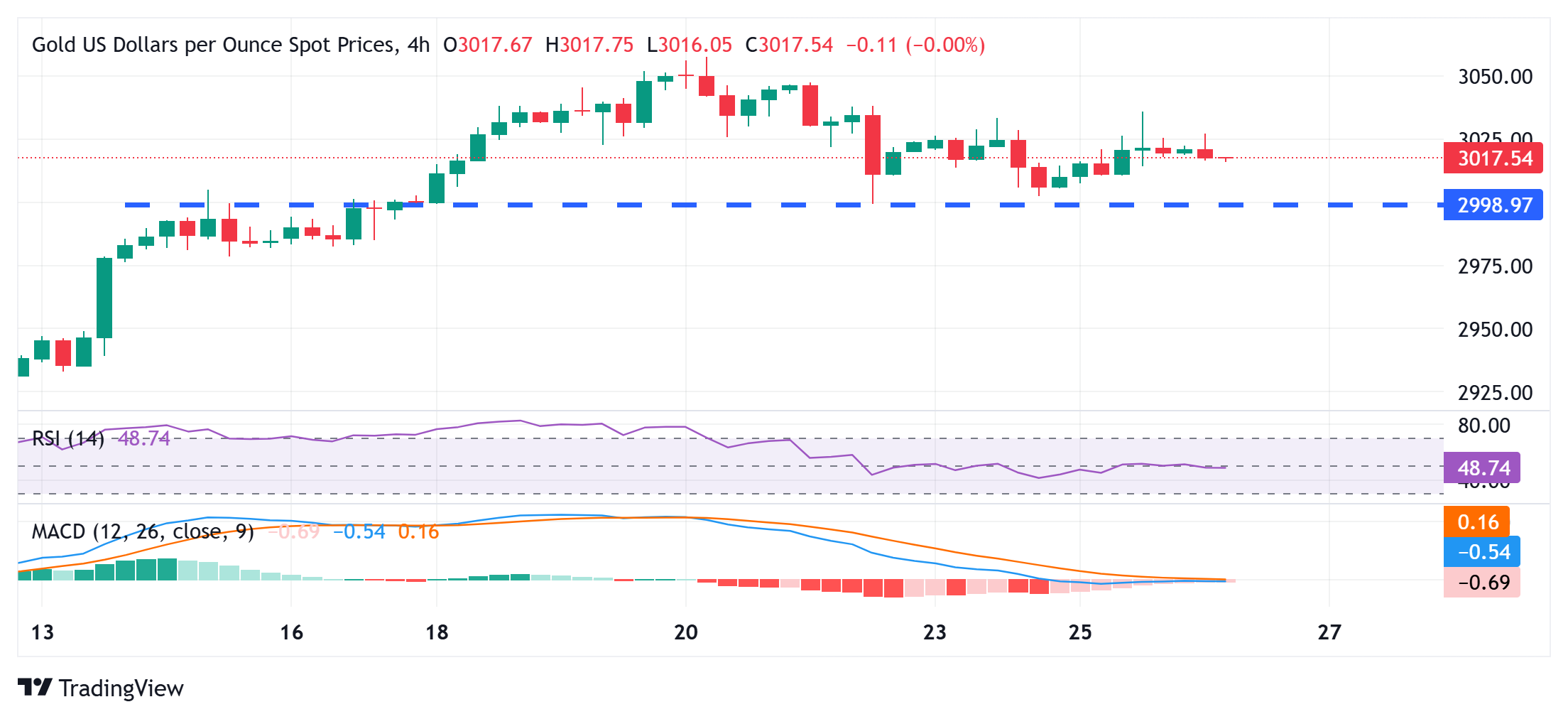- Gold price attracts buyers for the second straight day, though it lacks follow-through.
- Trade jitters, Fed rate cut bets and recession fears underpin the safe-haven commodity.
- A positive risk tone and the emergence of some USD buying cap the XAU/USD pair.
Gold price (XAU/USD) sticks to its positive bias through the first half of the European session on Wednesday and trades above the $3,025 level, though it lacks bullish conviction. The uncertainty over US President Donald Trump’s so-called reciprocal tariff announcement on April 2 turns out to be a key factor that continues to underpin the safe-haven bullion. Moreover, the Federal Reserve’s (Fed) forecast for two 25 basis points rate cuts by the end of this year further benefits the non-yielding yellow metal.
However, the emergence of some US Dollar (USD) buying, following the overnight pullback from a nearly three-week high, holds back traders from placing aggressive bullish bets around the Gold price. Apart from this, a generally positive risk tone contributes to capping the upside for the XAU/USD pair. Traders now look forward to the US Durable Goods Orders data for some impetus, though the market focus will remain glued to the release of the US Personal Consumption Expenditure (PCE) Price Index on Friday.
Daily Digest Market Movers: Gold price remains supported by US tariff fears
- The US Dollar retreated from a nearly three-week high after data released on Tuesday showed that the Conference Board’s US Consumer Confidence Index fell for a fourth straight month, to a four-year low level of 92.9 in March. The survey also revealed that the Expectations Index fell to 65.2, or the lowest level in 12 years and well below the threshold of 80 which usually signals a recession ahead.
- This comes after the Federal Reserve last week revised its growth outlook downward amid the uncertainty over the impact of US President Donald Trump’s trade policies. Moreover, reports that US reciprocal tariffs scheduled to be imposed on April 2 would be more targeted help ease inflation concerns and should allow the US central bank to keep cutting rates, benefiting the non-yielding Gold price.
- In fact, the Fed had signaled that it would deliver two 25 basis points interest rate cuts by the end of this year. The markets, however, are pricing in the possibility that the US central bank would lower borrowing costs in June, July, and October policy meetings. This overshadows hawkish remarks from Fed Governor Kugler, saying that she supports holding interest rates steady for some time.
- Meanwhile, Trump imposed a secondary tariff on Venezuela and said that any country that buys oil or gas from Venezuela would face a 25% tariff when trading with the US. Furthermore, Trump is expected to announce so-called retaliatory tariffs – that would offset levies on US goods and are set to take effect on April 2 – on about 15 major US trading partners, keeping investors on the edge.
- Russia and Ukraine have reached an agreement to halt military strikes in the Black Sea and on energy infrastructure following negotiations mediated by the US. Apart from this, the latest optimism over China’s stimulus aimed at boosting consumption remains supportive of a generally positive tone around the equity markets. This is holding back the XAU/USD bulls from placing aggressive bets.
- Traders now look forward to Wednesday’s release of US Durable Goods Orders, which, along with speeches by influential FOMC members, should provide some impetus to the USD and the commodity. The focus, however, will remain glued to the US Personal Consumption Expenditure (PCE) Price Index, which could provide cues about the Fed’s rate-cut path and drive the precious metal.
Gold price seems poised to appreciate further; $3,000 support holds the key
From a technical perspective, bullish resilience near the $3,000 mark and the subsequent move up, along with positive oscillators on the daily chart, suggest that the path of least resistance for the Gold price is to the upside. Some follow-through buying beyond the overnight swing high, around the $3,036 area, will reaffirm the constructive outlook and lift the XAU/USD pair towards the all-time peak, around the $3,057-3,058 zone touched last week.
On the flip side, the $3,000 mark should continue to protect the immediate downside for the Gold price and act as a key pivotal point. A convincing break below might prompt some technical selling and drag the XAU/USD pair to the $2,982-2,978 region. The corrective fall could extend further toward the next relevant support near the $2,956-2,954 resistance breakpoint.
US Dollar FAQs
The US Dollar (USD) is the official currency of the United States of America, and the ‘de facto’ currency of a significant number of other countries where it is found in circulation alongside local notes. It is the most heavily traded currency in the world, accounting for over 88% of all global foreign exchange turnover, or an average of $6.6 trillion in transactions per day, according to data from 2022. Following the second world war, the USD took over from the British Pound as the world’s reserve currency. For most of its history, the US Dollar was backed by Gold, until the Bretton Woods Agreement in 1971 when the Gold Standard went away.
The most important single factor impacting on the value of the US Dollar is monetary policy, which is shaped by the Federal Reserve (Fed). The Fed has two mandates: to achieve price stability (control inflation) and foster full employment. Its primary tool to achieve these two goals is by adjusting interest rates. When prices are rising too quickly and inflation is above the Fed’s 2% target, the Fed will raise rates, which helps the USD value. When inflation falls below 2% or the Unemployment Rate is too high, the Fed may lower interest rates, which weighs on the Greenback.
In extreme situations, the Federal Reserve can also print more Dollars and enact quantitative easing (QE). QE is the process by which the Fed substantially increases the flow of credit in a stuck financial system. It is a non-standard policy measure used when credit has dried up because banks will not lend to each other (out of the fear of counterparty default). It is a last resort when simply lowering interest rates is unlikely to achieve the necessary result. It was the Fed’s weapon of choice to combat the credit crunch that occurred during the Great Financial Crisis in 2008. It involves the Fed printing more Dollars and using them to buy US government bonds predominantly from financial institutions. QE usually leads to a weaker US Dollar.
Quantitative tightening (QT) is the reverse process whereby the Federal Reserve stops buying bonds from financial institutions and does not reinvest the principal from the bonds it holds maturing in new purchases. It is usually positive for the US Dollar.


